Celebrating 75 Years of Conservation
Billions of dollars have been funneled into state wildlife and outdoor recreation programs thanks to this ingenious law.

In 1937, President Franklin D. Roosevelt signed into law the Pitman-Robertson Act, which was the beginning of a comprehensive conservation program targeting state wildlife resources. Prior to the creation of the Pittman-Robertson Act, many species of wildlife were driven to or near extinction by hunting pressure and/or habitat degradation.The Act created an excise tax that provided funds to each state to manage such animals and their habitats. It was such a compelling idea that in 1950, Congress passed the Dingell-Johnson Act, now known as the Sport Fish Restoration Act.
Pitman-Robertson and Dingell-Johnson work in tandem to provide financial support to states managing for both fish and wildlife resources for current and future generations. These programs continue today to benefit wildlife and sport fishing in a very direct way: When people buy a license, tackle and all the equipment needed to hunt or fish, they generate the funds that federal law requires be set aside for the preservation of fish and wildlife. Marksmen, boaters and consumers of everything from binoculars to boat fuel contribute via user fees. Through these programs, past, current, and future generations of sportsmen and sportswomen provide the primary funding for conservation efforts benefitting fish and wildlife.
The Wildlife Restoration Program and the Sport Fish Restoration Program are two of the most successful conservation programs in our nation's history. They reflect a farsighted partnership between the federal government, state agencies, private industries, and hunters, anglers, shooters and boaters. We in Illinois are fortunate to have the following sport fish projects supported by this program:
Illinois Federal Aid Projects
F-52-R: Sport Fishing Creel Survey on the Illinois Portion of Lake Michigan
F-65-R: Illinois Lake Michigan Fishery Surveys and Investigations
F-69-R: Research and Analysis of Fisheries in Illinois
F-101-R: Long-Term Illinois, Mississippi, Ohio, and Wabash Rivers Fish Population Monitoring Program
F-123-R: Yellow Perch Population Assessment in Southwestern Lake Michigan
F-138-R: Growth and Survival of Nearshore Fishes in Lake Michigan
F-152-R: Surveys and Investigation for Sport Fish Management in Lakes and Rivers in Illinois
F-186-R: Assessment of Habitat Preference, Range, and Movement Patterns of Flathead Catfish (Pylodictis olivaris) on the Wabash River
Federal Aid Project F-52
Project Title: Sport Fishing Creel Survey on the Illinois Portion of Lake Michigan
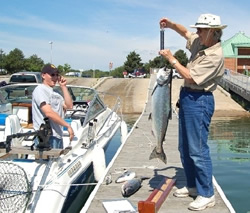
Effective management of fisheries requires regular assessment of sport fishing activity. In particular, accurate annual estimates of sport fishing activity, the numbers of fish harvested, and anglers' expenditures are needed to guide management decisions. We have conducted the sport fishing survey of the Illinois portion of Lake Michigan since 1985. This work has provided critical information on salmon, trout and yellow perch harvest, which aids IDNR and federal government in establishing stocking quotas and harvest limits to better manage the multi-million dollar Illinois Lake Michigan sport fishery.
Our survey is a contact creel where anglers are interviewed and data is collected on the angler's fishing trip that day. Information is collected for angler effort, catch, harvest and direct expenditures. Biological data is collected from fish in the angler's possession (length, weight, fin clips, tags, lamprey wounds and lamprey scars). The information collected is expanded to arrive at annual estimates. When compiled on a lake-wide basis, creel data serves as a unique tool to guide management and preserve a delicate balance between forage fish and highly desired salmon, trout, and yellow perch.
Federal Aid Project F-65-R
Project Title: Illinois Lake Michigan Fishery Surveys And Investigations
With its nearly 1 million acres in size, access to Pacific salmon and other non-native trout, and abundant fishing opportunities in a highly urbanized setting, Lake Michigan provides a unique fishery for the citizens of Illinois. Federal Aid project F-65-R assesses various components of the Lake Michigan fishery to ensure proper fisheries management.

Illinois DNR biologists conduct both offshore and nearshore surveys of the fish populations to develop management strategies. Spring gill netting surveys are used to monitor forage fishes and predators. Yellow perch population status is evaluated using gill nets for adults and beach seines for juveniles. Electrofishing occurs in harbors to assess non-perch and non-salmon fish that are available to anglers along the Illinois shoreline of Lake Michigan. In the fall, spawning lake trout are monitored on offshore reefs using gill nets and stocked salmon that return to the shoreline are assessed using electrofishing gear in harbors.
The Lake Michigan Program personnel utilize information from these fishery surveys to develop management strategies that provide for optimum sport fishing opportunities. Because Lake Michigan is a shared resource and the fish can move between jurisdictions, Program personnel also work with other Lake Michigan fishery management agencies. As part of a multi-agency collaboration, the ratio of wild Chinook salmon to stocked Chinook salmon is being evaluated by looking for the presence/absence of oxytetracycline marks (hatchery origin) in the vertebrate of Chinook salmon. More recently, coded-wire tags implanted in Chinook salmon in the hatchery have been used to determine stocking location and age of the fish.
Federal Aid Project F-69-R

For a complete look at F-69-R research projects, download the Sport Fish Research in Illinois brochure.
Project Title: The Fishes of Champaign County
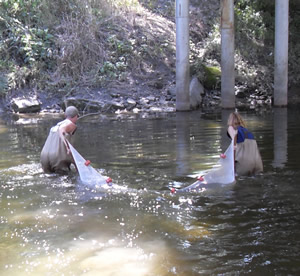
Building on the efforts of Forbes and Richardson (1908), Thompson and Hunt (1930), Larimore and Smith (1963), and Larimore and Bayley (1996), the next iteration of "The Fishes of Champaign County" (FoCC) began in the 2012 field season. The study includes the sampling of fish populations at pre-determined field sites, assembly and analysis of land use and stream habitat data, collection and analysis of physio-chemical habitat data, and analysis of the effect of fish community and environmental parameter interactions on distribution and assemblage characteristics. To the maximum extent practicable, field crews are replicating the sampling methods (e.g., electric seine and block nets) and locations (140+ sample sites) used in previous iterations of this long-term study (previously funded under Federal Research Project F-76-R).
To date, we have sampled 65 sites on the Kaskaskia, Embarras, Salt Fork and Middle Fork basins. From these sites, we collected almost 22,000 fish comprised of 68 species. Due to the drought we experienced in Illinois, low water conditions made smaller stream samplings unworkable. Therefore, in 2013, we plan to sample smaller streams early in the season and then move forward to concentrate our sampling on the Sangamon River Basin sites. Additional sites will also be chosen in accordance with this study.
Once fish sampling is complete, project personnel will analyze changes over time in the fish assemblages of prairie streams in east central Illinois and evaluate factors impacting stream fish populations. This information will help sport fish management decisions in the future.
Project Title: I Fish Illinois Website
F-69-R Project personnel maintain and enhance the website www.ifishillinois.org as the primary method for providing online information about sport fishing opportunities to the public. This website includes information about Illinois sport fish, including weekly fishing reports, findings on long-term analyses of sport fisheries data, trends in fishing quality, and the promotion of Illinois as a fishing destination. It also includes general information for the public regarding fishing licenses, site closures, best practices for catch-and-release fishing information, kid's fishing information, etc. This effort makes sport fisheries-related information readily available to the public and continues to provide immeasurable benefit to current and prospective anglers in Illinois.
Project Title: Lake Michigan Sport Fish Assessments
Project personnel and DNR staff have begun identifying current and future research needs relative to Great Lakes sport fish restoration for consideration as specific activities in future segments.
Project personnel have continued collaborations with the Illinois DNR Division of Fisheries to conduct research studies and management activities on Lake Michigan. Project staff continues to assist with spring index netting, yellow perch assessments, data collection for a lake-wide predator survey, summer harbor electrofishing, yellow perch beach seine netting, fall salmonid electrofishing, and fall lake trout spawning assessments. As part of a multi-agency collaboration, personnel have also continued collecting data for a project aimed at calculating the ratio of wild Chinook salmon to stocked Chinook salmon by looking for the presence/absence of oxytetracycline marks in the vertebrate of Chinook salmon.
Project Title: DuPage Stocking
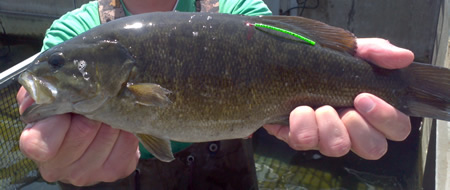
The DuPage County Forest Preserve District, the Illinois Department of Natural Resources (IDNR) and the University of Illinois Natural History Survey (INHS) have teamed up on a research and monitoring project of sport fish populations on the West Branch of the DuPage River. A large-scale Superfund clean-up and stream bed reconstruction on the West Branch of the DuPage River was recently completed. This area is where researchers will monitor, investigate and assess the recovery of sport fish populations in a restored urban stream, highlighting the potential for a quality urban stream fishery in the Chicago suburbs. As human populations urbanize, identifying and providing angling opportunities in densely populated urban areas has become an important component of fisheries management.
As the first steps in this project, F-69-R project personnel from the Jake Wolf Fish Hatchery stocked approximately 100 adult smallmouth bass (approximately 4-5 lbs each) in two locations on the West Branch of the DuPage River on May 30, 2012, and on October 9, 2012, IDNR personnel stocked 126 smallmouth bass, approximately 3.5 – 4 pounds in size, at two sites on The Des Plaines River at Riverside. These fish are identifiable to researchers and anglers by the presence of an external "Floy Tag" that, when captured by researchers, managers or the angling public, will provide important information about movement patterns, habitat use, and overall population size. Over the next several years, researchers at the INHS will use this data to investigate factors that affect the quality of sport fishing in urban streams and recommend management actions to enhance fishing opportunities in the area. Read more about this program here.
Project Title: Sport Fish Population and Sport Fishing Metric
Using long-term sport fisheries data, project staff has initiated the development and testing of a Fishing Quality Index (FQI) for individual species of sport fish. Fisheries-dependent data were assembled using creel survey data from 1990 - 2009 and collected in previous segments of Project F-69-R. Creel survey estimates for angler effort, angler catch, and catch biomass of largemouth bass were log-transformed to normalize their distributions, and a 0 to 5 scoring system was developed based on the standard deviation of each distribution. Development of the FQI has required project staff to access a wide variety of currently isolated, individually managed data sets. As such, project personnel have coordinated with DNR Division of Fisheries to discuss integration of these data sets to facilitate their use in FQI development as well as in other aspects of Project F-69-R. Procedures and methods for data assembly, analysis and FQI scoring schemes have been initiated for largemouth bass on Illinois lakes and impoundments and will extend to several other sport fish species and a sport fish community metric for individual lakes, rivers and streams in Illinois.
Project Title: Experiments to Determine Factors Affecting Fishing Quality
In the current segment, project personnel conducted field studies examining processes that determine reproductive success in largemouth bass with the goal of gaining a better understanding of how angling during the reproductive period may influence recruitment dynamics and ultimately fishing quality. These experiments showed that there is a direct, positive relationship between the number of reproductively successful nests within a population of smallmouth bass and recruitment to age 1+ the following season. Preliminary results of study concurrently being conducted indicate a similar relationship between reproductive success and recruit abundance in largemouth bass with further analyses on this 20-year data set currently in progress. The results of another experiment examining the impact of brood loss on nest abandonment decisions by largemouth bass demonstrate that experimental brood depredation induces premature nest abandonment by parental largemouth bass. Together these studies show how angling is an important component of recruitment dynamics in black bass, and how life history characteristics are critical factors in understanding variability in sport fish abundance and ultimately fishing quality.
Project Title: Development of Novel Stress Markers for Sport Fish
The development of novel genetic stress markers allows for the determination of cellular distress in organism over a wide variety of life stages and environmental parameters, which would not be possible using traditional techniques. The overall goal of the project is to develop a suite of genetic stress markers for important sport fish species in Illinois, specifically largemouth bass and bluegill, to more accurately define the stress response of these species to differing environmental conditions. After fish were exposed to either high carbon dioxide concentrations, low dissolved oxygen concentrations or ambient conditions, blood and tissues largemouth bass and bluegill were used to perform a variety of genetic assays. A number of genetic tools were subsequently developed for these sport fish including several general stress markers, a low oxygen stress marker, and an elevated carbon dioxide marker. Results generated will provide a more detailed account of the overall stress response of these fish to differing environmental conditions. The ability to determine the overall stress response of sport fish at almost any age or size class is an incredibly powerful tool that can help define the proper water quality conditions for optimal fish health.
Federal Aid Project F-101-R
Project Title: The Long-Term Illinois, Mississippi, Ohio, and Wabash Rivers Fish Population Monitoring Program
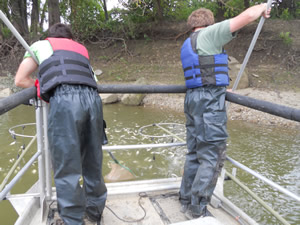
This Federal program monitors fish communities throughout the Illinois River and Illinois portions of the Mississippi, Ohio, and Wabash rivers by pulsed-DC electrofishing, providing fisheries managers with constant, up-to-date information on large river sport fish populations, including relative abundance, size structure, and body condition. Pulsed-DC electrofishing began in 2009, and is intended to be a continuous, long-term project which will show researchers how sport fish populations change over time and how they vary among different reaches of river. In addition, this sampling is directly comparable to electrofishing conducted as part of the Long Term Resource Monitoring program (LTRM), which monitors fish communities throughout the Upper Mississippi River system.
Since 1989, F-101-R has continued an AC electrofishing program on the Illinois River that first began in 1957. This program continues to use the same methods from when it began and has showed changes in the Illinois River fish community as water quality improved since the 1970s. The research has shown a clear difference in fish communities between the upper river and lower river. Project F-101-R also funds graduate students researching Asian carp and catfish populations.
Project Title: Population Assessment of Catfishes in the Ohio River
Flathead catfish, channel catfish, and blue catfish are important commercial and sport fish species throughout much of their ranges in North America. The Ohio River supports substantial commercial and recreational fisheries for catfishes,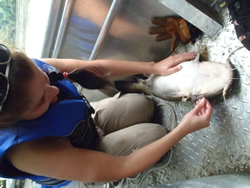 but data on characteristics of catfish populations in the Ohio River is limited. This federal project was developed to provide the Illinois Department of Natural Resources with critical baseline data on Ohio River catfish populations that will aid in management decisions for these species. For this project, we are monitoring abundance, age and size distribution, condition, mortality, and growth rates of flathead, blue and channel catfish in the Illinois portion of the Ohio River. We are also identifying source environment (Ohio River or tributaries) of catfishes in the Ohio River using naturally-occurring chemical "fingerprints" in catfish fin spines and otoliths (earstones). Analysis of environment-specific chemical "fingerprints" in relation to locations of growth rings in these structures enables determination of environments occupied by an individual fish during its lifetime.
but data on characteristics of catfish populations in the Ohio River is limited. This federal project was developed to provide the Illinois Department of Natural Resources with critical baseline data on Ohio River catfish populations that will aid in management decisions for these species. For this project, we are monitoring abundance, age and size distribution, condition, mortality, and growth rates of flathead, blue and channel catfish in the Illinois portion of the Ohio River. We are also identifying source environment (Ohio River or tributaries) of catfishes in the Ohio River using naturally-occurring chemical "fingerprints" in catfish fin spines and otoliths (earstones). Analysis of environment-specific chemical "fingerprints" in relation to locations of growth rings in these structures enables determination of environments occupied by an individual fish during its lifetime.
This project will provide valuable insights on population dynamics and will identify environments important to early life stages for Ohio River catfishes. A companion project is being conducted on the Wabash River to compare catfish population dynamics in these two connected rivers and assess the extent to which Ohio River and Wabash River catfish populations are linked.
Information gained through this project will allow the IDNR to make research-based management decisions to maintain or enhance catfish populations in the Ohio River.
Project Title: Nutrition and Condition of Silver Carp across Large Illinois Rivers
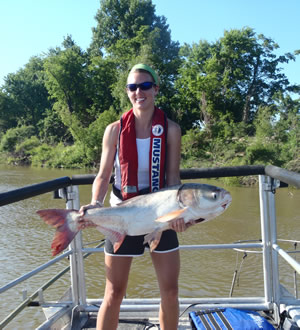
The long-term Illinois, Mississippi, Ohio, and Wabash river fish population monitoring program (LTEF) has been monitoring fish populations in Illinois rivers since 1957. With additional funding provided by the Illinois Department of Natural Resources, it is imperative to report the catch per unit effort (CPUE) of various species and population sizes of the fish caught for a better understanding of how our river ecosystems may be changing. Since the introduction of invasive Asian carp to the Illinois River in the 1990s, their populations have increased exponentially and spread to other large rivers in Illinois. As such, Asian carp may be competing with important native sport fish for food and habitat resources.
The goal of this project is to improve our understanding of whether external parameters (e.g., season, habitat, con-specifics) influence the health and condition of Asian carp, with a particular emphasis on broad spatial scales. In order to achieve this goal, physiological parameters of silver carp are being quantified to test for relationships across several established populations; in addition, they are also being compared with biotic and abiotic factors. Silver carp blood sampling is occurring on the Illinois, Ohio, Mississippi, and Wabash Rivers across three time periods (mid-summer, late-summer, and fall). Plasma is then analyzed for stress and nutritional parameters. With this information, we can gain a better understanding of whether different environments affect the health and condition of silver carp as a mechanism that may influence their spread and distribution. This research is important because it will answer the unknown of how these fish will fare outside of their current range and help us to predict where they will thrive outside of their native ranges.
Federal Aid Project F-123-R
Project Title: Yellow Perch Population Assessment in Southwestern Lake Michigan
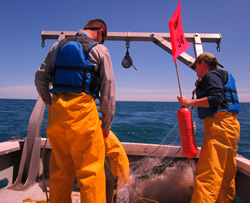
Yellow perch is an important commercial and sport fish throughout much of its range in North America. Every year, yellow perch fishing attracts thousands of anglers to the shores of Lake Michigan, and annual harvest in Illinois waters alone has peaked at over one million fish. This federal project was developed to provide the Illinois Department of Natural Resources with critical data to aid management decisions and address constituent concerns about the yellow perch population in southwestern Lake Michigan. In addition, results of this project (e.g., index of yellow perch year-class strength) are utilized by the Lake Michigan Technical Committee to formulate lake-wide management strategies. In coordination with the Yellow Perch Task Group, project objectives have been formed to develop a yellow perch decision analysis model, which is a tool for managers to project the effects of regulations and harvest on population stability.
Over the course of this project we have identified critical habitat for adult and juvenile yellow perch, as well as factors that affect the survival of yellow perch during early life stages. Most recently, we synthesized age-0 yellow perch year-class strength data and evaluated factors affecting their recruitment dynamics during the past 20 years. We found that young yellow perch benefited from relatively warmer years, and did better during times of low alewife abundance and high zooplankton density. This long-term monitoring project provides extremely valuable insights on yellow perch population dynamics in Lake Michigan and is a vital tool for state and lake-wide management efforts, which ultimately benefits thousands of avid perch anglers throughout the Lake Michigan basin.
Federal Aid Project F-138-R
Project Title: Growth and Survival of Nearshore Fishes in Lake Michigan
.jpg)
The nearshore of Lake Michigan is a diverse and dynamic area where key biological processes take place. This region, on the interface of land and water, provides critical habitat (e.g., spawning, nursery, feeding and refuge) for a variety of aquatic animals, including sport fish. This federal project was developed to provide the Illinois Department of Natural Resources with critical information on biological interactions in this vital area of the lake. To account for habitat diversity, we monitor fish abundance and composition along with habitat preferences at multiple sites along the Illinois shoreline. We also determine prey availability for yellow perch, bass, salmon and trout. Finally, we evaluate factors affecting abundance and composition of fish communities and the impacts of invasive species (e.g., zebra and quagga mussels,and round goby) on native biota.
Information gained through this project allows IDNR to make research-based management decisions regarding angler harvest limits or salmon and trout stocking quotas. Through this project, we also help to identify preferred areas for habitat protections and/or restoration. This project has also answered several pressing questions related to the function of an artificial reef near Chicago and helped to develop recommendations for future reef building projects in the Great Lakes.
Federal Aid Project F-186-R
Project Title: Assessment of Habitat Preference, Range, and Movement Patterns of Flathead Catfish (Pylodictis olivaris) on the Wabash River
![]() Eastern Illinois University began a Flathead Catfish movement study on the Wabash River in August of 2012. This study is beneficial to not only broaden our knowledge of the behavior of these fish, but to assist fisheries managers in appropriate management plans for the species in large rivers. The Wabash River is an ideal water system for this study because the lower 400 miles is completely free flowing, making it possible for fishes to naturally move freely throughout. This is extremely beneficial for movement research because we are able to track natural movements of fish, without restrictions. Dr. Rob Colombo is heading this research with the aid of several graduate and undergraduate students.
Eastern Illinois University began a Flathead Catfish movement study on the Wabash River in August of 2012. This study is beneficial to not only broaden our knowledge of the behavior of these fish, but to assist fisheries managers in appropriate management plans for the species in large rivers. The Wabash River is an ideal water system for this study because the lower 400 miles is completely free flowing, making it possible for fishes to naturally move freely throughout. This is extremely beneficial for movement research because we are able to track natural movements of fish, without restrictions. Dr. Rob Colombo is heading this research with the aid of several graduate and undergraduate students.

Flathead Catfish were collected using DC boat electrofishing from several sites along the Wabash River, including Darwin, St. Francisville, and New Harmony. Fish in this study are implanted with an ultrasonic coded transmitter, which is used to track their movement. In addition, to easily identify Flathead Catfish being used in this research, floy tags are secured to the dorsal fin, which contain EIU information and individual fish identification numbers.
The purpose of this study is to research the large- and small-scale movements of the fish to determine their behavior along with their environment. The proper habitat is critical for the fishes' success. It's important to protect against over-harvesting this species, while being able to utilize it as the flathead catfish is one of the most-sought-after species in the Wabash River by anglers. At this time, all research indicates that the flathead catfish population in the  Wabash River is quite healthy.
Wabash River is quite healthy.
The information we obtain from this research will provide managers and scientists with vital behavioral information about the Flathead Catfish population in the Wabash River and will be able to apply this information for management strategies on large rivers.
Read more about the research being done on the Wabash River.




